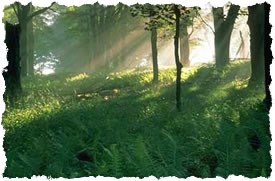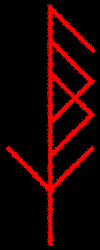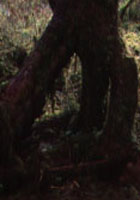|
This ritual is meant to exemplarily show how
methods of western ritual magic can be put to use in a runemagical
or a freestyle shamanist context. The purpose of the ritual is to
give back to a place some of it's original, magical nature by
summoning spirits to it. It is not intended to be as much of a
strict set of rules as it may be an example for this kind of rite.
The ritual as described here has been performed successfully.
Since, however, the wishes and liking of the individual forces
involved are, true to shamanic paradigm, given much consideration
in it, it is rather likely each performance of it will vary a
little in one aspect or another. Most forest spirits, most notably
the fairy folk, are somewhat at odds with man-made regulations
anyway, so it would be pointless to expect them to behave in any
particular way just because some arbitrary ritual instruction
would like them to. :-)
Preparation
 Before
everything else, it's all about finding a place. But this term may
be inaccurate: ultimately, a place is meant to be helped by means
of the ritual, so it may well be you are, in which way ever, told
the rite would be appropriate in some place or the other. In any
case, the approval of the spirit of the place is an absolutely
necessary prerequisite. Before
everything else, it's all about finding a place. But this term may
be inaccurate: ultimately, a place is meant to be helped by means
of the ritual, so it may well be you are, in which way ever, told
the rite would be appropriate in some place or the other. In any
case, the approval of the spirit of the place is an absolutely
necessary prerequisite.
In the following ritual, a condition that in
principle is a stable one - the relatively low population of
nature spirits in a given area - is to be transformed into a new,
also stable one. The spirits called are meant to stay here. If the
change is to be permanent, it has to be ensured the new condition
will not be disturbed. In a shamanic view of the world, no other
force (i.e. no other spirit) must disturb it. If an intervention
of another spirit being seems likely, it is your responsibility
whether to convince the being of approval, to force it to it or to
refrain from the ritual.
Apart from this approval, you don't need much: a sacrifice
(such as a bottle of alcohol), at least fifteen incense sticks of
a fitting scent (such as Patchouli), a drum or other instument if
you wish to use one (see below) as well as any magical weapons
like the staff, hammer or dagger you might wish to include.
 Finally,
a sigil for the species of spirits that is to be summoned has to
be prepared. The example in the picture is a binding rune created
out of the runes Ansus, Lagus, Fehu and Algis - alfR is Elves in
the ancient nordic language. Finally,
a sigil for the species of spirits that is to be summoned has to
be prepared. The example in the picture is a binding rune created
out of the runes Ansus, Lagus, Fehu and Algis - alfR is Elves in
the ancient nordic language.
Performance
Normally, it is recommendable the ritual is done by night.
Although the appropriate time depends on who you want to summon -
in the case of elves, who fancy any kind of transition, dawn or
twilight could be it - spirits of the woods are typically
nocturnal ones.
You might also consider the psychological
component of being in the forest at night and the much less
significant danger of being troubled by walkers.
After arrival on the place in question, meditations and
centerings are performed as may be individually necessary and all
tools are situated in the center of the location. Followers of a
natural religion might find it appropriate to create a small altar
for the local spirits in the middle of the place.
 A
spot on the edge of the site, preferrably a dark one, is chosen.
Openings on the ground, in rootstocks or in the underwoods, are
especially favorable. The sacrifice is made to the spirit of the
place and the spirit world in general, possibly accompanied by
shamanic trance, prayer or speaking to the spirits. Now, a
banishment is performed. The hammer rite as introduced by Edred
Thorsson is especially fitting in matters of style, but any method
that works somewhat smoothly and easily will do as well. A
spot on the edge of the site, preferrably a dark one, is chosen.
Openings on the ground, in rootstocks or in the underwoods, are
especially favorable. The sacrifice is made to the spirit of the
place and the spirit world in general, possibly accompanied by
shamanic trance, prayer or speaking to the spirits. Now, a
banishment is performed. The hammer rite as introduced by Edred
Thorsson is especially fitting in matters of style, but any method
that works somewhat smoothly and easily will do as well.
After that, or (in case the rite is done by a group and not
everyone is busy banishing) at the same time, the incense sticks
are put into the ground in a large spiral array and are lit. Two
of the sticks are positioned to the left and right, respectively,
of the spot that is going to become the gate.
The spiral form is, one the one hand, to
express affiliation to the natural, earthbound current of magic
and, on the other, as a symbol of birth and life emphasizes the
positive character of the whole rite.
 Using
one of the magical weapons or the pointing finger, the outlines of
the gate are drawn into the air and visualized. It can be helpful
to draw the lines several times over. When the gate is there, the
prepared sigil is drawn upon it in the same manner. While doing
this, the name of the spirit people is vibrated or sung. In the
case of the already mentioned binding rune this would obviously be
"alfR". Using
one of the magical weapons or the pointing finger, the outlines of
the gate are drawn into the air and visualized. It can be helpful
to draw the lines several times over. When the gate is there, the
prepared sigil is drawn upon it in the same manner. While doing
this, the name of the spirit people is vibrated or sung. In the
case of the already mentioned binding rune this would obviously be
"alfR".
By means of the sigil, the gate gets an "other
side". It now leads to a well defined place, which is the one
where the named beings live.
When these preparations have been made satisfactorily, the gate
is opened using a single word: "Mellon!"
Anyone who doesn't recognize this word should
go and read the "Lord of the Rings" urgently. :-) It means
"friend" and is used in said book for opening the gate to the old
dwarven realm of Moria.
The opening of the gate and the region on it's other side wil
be visible with about the same intensity as the gate has been
visualized before. Now, the last phase of the rite can begin; in
it, the spirits on the other side of the gate are made aware of
the place they are meant to come to, and called to it. The most
obvious method for this is probably shamanic drumming in deep
trance. However, trance dancing, speaking to the powers in chaos
language (speaking in tongues, glossolalia), fervent prayer to the
responsible deity or another material sacrifice could be applied.
By these means, the spirits are fed and
attracted to the place the ritual is performed at. To observe and
visualize the beings that come out of the gate is interesting, but
not necessary.
Whenever it appears to be enough, the calling is ended. All
tools are collected back together and the place is left quickly.
Final giving of thanks, earthing and centering should be performed
when the place is out of sight, at the earliest.
If the weather is very moist, the incense
sticks can be left burning.
www.sacred-magick.com
Powered By:
Soluzen
Hosting Solutions |